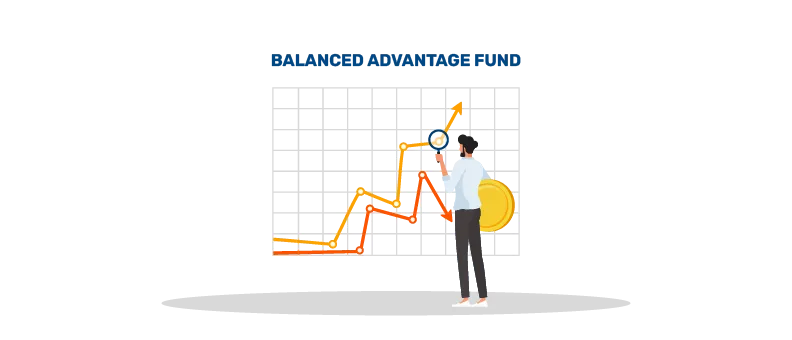What role does a balanced advantage fund play in mitigation of downside impact?


Investing in the stock market can be like riding a roller coaster – thrilling highs and scary lows. While the charm of potential gains draws many, the fear of market downturns is a constant concern. Balanced Advantage Fund emerge as a potential solution, providing investors with a unique approach that aims to make the most of market highs while seeking to cushion against the impact of downturns.
This article explores the role these funds play in containing impact on portfolios from market downside.
- Table of contents
- Understanding Downside Impact in Markets
- Understanding downside protection
- Role of balanced advantage funds in mitigating impact of downside movement
- Key strategies of balanced advantage funds to mitigate downside risk
- Considerations for investors
- Performance analysis of balanced advantage funds in downside mitigation
Understanding downside impact on markets
Downside impact refers to the risk of substantial losses in investments, emphasizing the severity, probability, and duration of declines in portfolio value. It can range from short-term market corrections to prolonged downturns.
Factors contributing to downside impact:
Economic slowdown: Recessions, inflation, and interest rate hikes can weaken markets.
Geopolitical events: Wars, political instability, and trade disputes can create uncertainty and market declines.
Unexpected events: Disasters, pandemics, or tech disruptions can cause sudden market impacts.
Market psychology: Investor panic and herd behavior can amplify downturns.
Understanding downside protection
Before going further into the role of balanced advantage funds, let's understand what downside protection means. In the investment world, downside protection means reducing the negative impact when the overall market goes down.
Role of balanced advantage funds in mitigating impact of downside movement
Active asset allocation
Unlike traditional equity or debt funds that maintain a fixed allocation, balanced advantage funds continuously reassess and reallocate their assets. During bullish phases, they may increase exposure to equities to capture potential gains. On the other hand, in bearish markets, they may shift towards debt instruments to prevent significant erosion of capital.
Risk management
By adapting to changing market dynamics, balanced advantage funds aim to reduce the impact of market downturns on the overall portfolio. This dynamic approach helps in reducing impact on capital during challenging market conditions.
Market valuation metrics
Balanced advantage funds often use market valuation metrics to determine their asset allocation. For example, they may consider parameters like Price-to-Earnings (P/E) ratio to gauge whether markets are overvalued or undervalued. This data-driven approach guides their allocation decisions for optimal downside mitigation.
The Bajaj Finserv Balanced Advantage Fund offers both Direct and Regular Plans, providing investors with options based on their preferences and investment goals. Investors can begin with a lumpsum as low as Rs. 500, with SIP options available starting from Rs. 500 up to Rs. 1,000 for specific durations. Furthermore, there is no entry load, and no exit load applies after 6 months. This fund maintains a flexible asset allocation strategy, allowing a maximum equity exposure of 90% and a minimum of 65% to ensure equity oriented taxation. Debt and money market instruments can range from 10% to 35%. For a detailed scheme information, click here.
Key strategies of balanced advantage funds to mitigate downside risk
Balanced advantage funds can use various strategies to reduce the impact of market downturns, focusing on dynamic asset allocation and valuation-based adjustments, among other approaches.
Dynamic asset allocation: Balanced advantage funds can adjust the proportion of equities and debt based on market conditions. During downturns, they may reduce equity exposure and increase the debt allocation to mitigate downside risk.
Valuation-based adjustments: Using quantitative models, balanced advantage funds can assess market valuations. They may reduce equity exposure when markets reach their peak and increase it when markets are undervalued to capture potential growth.
Considerations for investors
Risk tolerance
Understand your risk tolerance and investment goals. While these funds aim for downside mitigation, they still carry some level of risk, especially during extreme market conditions. Assess whether the fund's risk profile aligns with your risk tolerance.
Investment horizon
Consider your investment horizon. Balanced advantage funds are designed for investors with a medium to long-term horizon. Short-term fluctuations might not allow the fund sufficient time to adjust its allocation for optimal performance.
Expense ratios
Evaluate the expense ratios of the fund. While actively managed funds generally have higher expenses, the benefits in terms of downside mitigation and potential returns should justify the costs.
Also Read : What is Total Expense Ratio in mutual funds?
Performance analysis of balanced advantage funds in downside mitigation
Balanced advantage funds usually follow one of two strategies: counter-cyclical and pro-cyclical.
Most funds go with the counter-cyclical approach. Here, they use things like price to earnings (P/E) or price to book value (P/B) to decide how much money should be in stocks (equity). In the counter-cyclical strategy, when the market is doing well, the fund puts less money in stocks. When the market isn't doing so great, it adds more money to stocks. Basically, it adjusts how much is invested in stocks based on how the equity market is performing.
On the other hand, there's the pro-cyclical strategy. In this strategy, the fund puts more money in stocks when the market is going up and reduces it when the market is going down. The idea here is to catch the good times in a rising market and mitigate against losses when the market is falling.
Conclusion
Balanced advantage funds can help investors steer through the unpredictable stock market. They can change their asset allocation, use smart strategies to manage risks, and look at how expensive or cheap the market is to make investment decisions.
FAQs:
How do balanced advantage funds mitigate the impact against market downturns?
Balanced advantage funds mitigate the impact against market downturns by actively adjusting their asset allocation. During bullish phases, they may increase equity exposure for potential gains, and during bearish markets, they may shift towards debt instruments to mitigate impact on capital.
How do balanced advantage funds differ from other types of funds in terms of downside mitigation?
Balanced advantage funds differ from other funds in their active and dynamic asset allocation strategy. Unlike traditional equity or debt funds with fixed allocations, these funds continuously reassess market conditions and adjust their portfolios.
How do asset allocation decisions impact downside mitigation in these funds?
Asset allocation decisions in balanced advantage funds directly impact downside mitigation. The funds use market valuation metrics to determine whether to increase or decrease exposure to equities/ debt securities.
What role does diversification play in downside risk mitigation?
Diversification can reduce unsystematic risk by spreading investments across sectors, mitigating the impact of losses in a single sector or stock. Diversification across asset classes can further mitigate downside risk because each asset class tends to respond differently to market conditions. For instance, during volatility, debt securities may offer relative stability as people seek out less volatile avenues.
How frequently do balanced advantage funds rebalance their portfolios?
The rebalancing frequency of Balanced Advantage Funds (BAFs) is market-driven and varies. There's no fixed schedule, and rebalancing occurs based on market conditions, volatility, and valuations. Fund managers' strategies and risk tolerance also influence the frequency, which could range from daily to less frequent intervals, depending on market dynamics.
Is there a downside to investing in balanced advantage funds?
Balanced Advantage Funds may offer lower growth potential during bull markets as compared to pure equity funds because they need to maintain some debt allocation in their portfolio. They may also have higher expense ratios because of their dynamic management approach. Additionally, the fund manager’s decision making and ability to swiftly respond to market conditions can play a significant role in the fund’s performance. Standard market risks that affect all market-linked investments also apply.
How do balanced advantage funds perform during market downturns?
Balanced Advantage Funds aim to mitigate loss during market downturns by dynamically adjusting equity and debt exposure. They may increase exposure to debt during volatility or downturns and reduce weightage of equity in their portfolio. This flexibility can help reduce drawdowns compared to pure equity funds, but it cannot eliminate risk of loss.
Related Searches:
Mutual Fund investments are subject to market risks, read all scheme related documents carefully.
This document should not be treated as endorsement of the views/opinions or as investment advice. This document should not be construed as a research report or a recommendation to buy or sell any security. This document is for information purpose only and should not be construed as a promise on minimum returns or safeguard of capital. This document alone is not sufficient and should not be used for the development or implementation of an investment strategy. The recipient should note and understand that the information provided above may not contain all the material aspects relevant for making an investment decision. Investors are advised to consult their own investment advisor before making any investment decision in light of their risk appetite, investment goals and horizon. This information is subject to change without any prior notice.
Mutual Fund investments are subject to market risks, read all scheme related documents carefully.
This document should not be treated as endorsement of the views/opinions or as investment advice. This document should not be construed as a research report or a recommendation to buy or sell any security. This document is for information purpose only and should not be construed as a promise on minimum returns or safeguard of capital. This document alone is not sufficient and should not be used for the development or implementation of an investment strategy. The recipient should note and understand that the information provided above may not contain all the material aspects relevant for making an investment decision. Investors are advised to consult their own investment advisor before making any investment decision in light of their risk appetite, investment goals and horizon. This information is subject to change without any prior notice.
The content herein has been prepared on the basis of publicly available information believed to be reliable. However, Bajaj Finserv Asset Management Ltd. does not guarantee the accuracy of such information, assure its completeness or warrant such information will not be changed. The tax information (if any) in this article is based on prevailing laws at the time of publishing the article and is subject to change. Please consult a tax professional or refer to the latest regulations for up-to-date information.